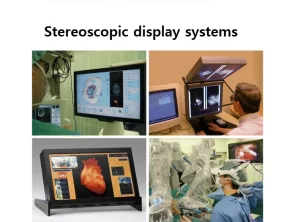Stereoscopic display systems features, advantages and disadvantages
Stereoscopic display exhibits multi-angle to the audience and it is more intuitive, The stereoscope is the device for viewing stereo-graphic cards that contain two separate images which are printed side by side to create the illusion of a three-dimensional image, Stereo display (also 3D display) is the display device capable of conveying the depth perception to the viewer.
Stereoscopic display systems
The real 3D displays display the image in three full dimensions, The most notable difference from the stereoscopic displays with only two 2D offset images is that the observer’s head and eye movement will increase the information about the 3-dimensional objects being displayed.
Stereoscopic display can create the illusion of 3-D when displayed, and Volumetric displays can create 3-D computer graphics image, but fail to offer many visual depth cues of overlap, Discrete parallax can create 3-D images with all of the depth cues, but they are limited by achievable resolution.
Stereo displays present the offset images that are displayed separately to the left and right eye, Both of these 2D offset images are combined in the brain to give the perception of 3D depth, The presentation of dual 2D images is different from displaying an image in three full dimensions.
The accurate term “stereoscopic” is more cumbersome than the common misnomer “3D”, Although most stereoscopic displays do not qualify as real 3D displays, all real 3D displays are also stereoscopic displays because they meet lower criteria as well, Stereoscopic technology offers a different image to the viewer’s left and right eyes.
The following are some of the technical details in some of the stereoscopic systems that have been developed, Each of these display technologies can be seen to have limitations, whether the location of the viewer, cumbersome or unsightly equipment, or great cost, The display of artifact-free 3D images remains difficult.
Side-by-side images
Traditional stereoscopic photography consists of creating a 3-D illusion starting from a pair of 2D images, The easiest way to enhance depth perception in the brain is to offer the eyes of the viewer with two different images, representing two perspectives of the same object, with a minor deviation exactly equal to the perspectives that both eyes naturally receive in the binocular vision.
Eyestrain and distortion are to be avoided, When the picture contains no object at an infinite distance, such as the horizon or the cloud, the pictures should be spaced correspondingly closer together, The side-by-side method is simple to create, but it can be difficult or uncomfortable to view without optical aids.
Transparency viewers
Pairs of stereo views printed on the transparent base are viewed by transmitted light, One advantage of transparency viewing is the opportunity for a wider, more realistic dynamic range than is practical with the prints on an opaque base, another is that a wider field of view may be presented since the images, being illuminated from the rear, may be placed much closer to the lenses.
The user wears the helmet or the glasses with two small LCD or OLED displays with magnifying lenses, one for each eye, The technology can be used to show stereo films, images, or games, Head-mounted displays may be coupled with head-tracking devices, allowing the user to look around the virtual world by moving their head, that eliminates the need for a separate controller.
Owing to rapid advancements in computer graphics and the continuing miniaturization of video and other equipment, these devices are beginning to become available at more reasonable cost, Head-mounted or wearable glasses are used to view a see-through image imposed upon the real world view, to create what is called an augmented reality.
This is done by reflecting the video images via the reflective mirrors, The recent development in holographic waveguide or waveguide-based optics allows the stereoscopic images to be superimposed in the real world without the use of bulky reflective mirror.
Head-mounted projection displays
Head-mounted projection displays (HMPD) are similar to head-mounted displays but with the images projected to and displayed on the retro-reflective screen, The advantage of this technology over the head-mounted display is that the focusing and vergence issues don’t require fixing with the corrective eye lenses, For the image generation, Pico-projectors is used instead of LCD or OLED screen.
Anaglyph 3D
Anaglyph 3D is the archetypal 3D glasses, It is similar to the red/green & red/blue lenses that are used to view early anaglyph films, The two images are superimposed in the additive light setting through two filters, one red and one cyan, In a subtractive light setting, the two images are printed in the same complementary colors on the white paper.
The glasses with colored filters in each eye separate the appropriate images by canceling the filter color out & rendering the complementary color black, a compensating technique, It is commonly known as Anachrome, It uses a slightly more transparent cyan filter in the patented glasses associated with the technique, The process reconfigures the typical anaglyph image to have less parallax.
Color-code 3-D is an alternative to the usual red and cyan filter system of anaglyph, The patented anaglyph system that was invented to present an anaglyph image in conjunction with the NTSC television standard, in which the red channel is compromised, Color-code uses the complementary colors of yellow and dark blue on-screen, The colors of the glasses’ lenses are amber and dark blue.
Polarization 3D systems
Polarization systems resemble sunglasses, RealD circular polarized glasses are the standard for theatrical releases & theme park attractions, To present the stereoscopic picture, two images are projected superimposed onto the same screen through different polarizing filters, The viewer wears the eyeglasses that contain a pair of polarizing filters oriented differently.
As each filter passes only the light that is polarized & blocks the light polarized differently, each eye sees a different image, This is used to produce a three-dimensional effect by projecting the same scene into both eyes but depicted from slightly different perspectives.
Circular polarization offers a benefit over linear polarization, The viewer does not need to have his head upright & aligned with the screen for the polarization to work properly, With linear polarization, turning glasses sideways causes the filters to go out of alignment with the screen filters causing the image to fade & for every eye to see the opposite frame easily.
For circular polarization, The polarizing effect works regardless of how the viewer’s head is aligned with the screen such as tilted sideways or even upside down, The left eye will still only see the image intended for it, and vice versa, without fading or cross-talk.
Polarized light reflected from the ordinary motion picture screen loses most of its polarization, So, an expensive silver screen or aluminized screen with negligible polarization loss has to be used, All types of polarization will result in a darkening of the displayed image and poorer contrast compared to non-3D images.
The light from the lamps is emitted as a random collection of polarizations, while the polarization filter only passes a fraction of light, So, the screen image is darker, This darkening can be compensated by increasing the brightness of the projector light source.
When the initial polarization filter is inserted between the lamp and the image generation element, the light intensity striking the image element is not any higher than normal without the polarizing filter, and the overall image contrast transmitted to the screen is not affected.
Active shutter 3D system
In the eclipse method, a Pair of LCD shutter glasses is used to view XpanD 3D films, The thick frames conceal the electronics and batteries, The shutter blocks the light from each eye when the converse eye’s image is projected on the screen, and the display alternates between left and right images, and opens and closes the shutters in the glasses or viewer in synchronization with the images on the screen, This was the basis of the Teleview system.
The variation on the eclipse method is used in LCD shutter glasses, The glasses contain liquid crystal that will let the light through in synchronization with the images on the cinema, television, or computer screen, by using the concept of alternate-frame sequencing.
It is used by nVidia, XpanD 3D & earlier IMAX systems, The drawback of this method is the need for each person viewing to wear expensive, electronic glasses which must be synchronized with the display system using the wireless signal or attached wire.
However these systems do not require a silver screen for the projected images, Shutter-glasses are heavier than most polarized glasses, though lighter models are no heavier than some sunglasses or deluxe polarized glasses .
Liquid crystal light valves work by rotating the light between two polarizing filters, Due to these internal polarizers, LCD shutter glasses darken the display image of any LCD, plasma, or projector image source, So, The images appear dimmer and contrast is lower than for normal non-3D viewing, for some types of displays which are very bright with poor grayish black levels, LCD shutter glasses may improve the image quality.
Interference filter technology
Dolby 3D uses specific wavelengths of red, green & blue for the right eye, and different wavelengths of red, green, and blue for the left eye, The eyeglasses that filter out very specific wavelengths allow the wearer to see the 3D image.
Interference filter technology eliminates the expensive silver screens required for polarized systems such as RealD, which is the most common 3D display system in the theaters, It requires much more expensive glasses than the polarized systems, It is known as spectral comb filtering or wavelength multiplex visualization.
The recently introduced Omega 3D/Panavision 3D system also uses this technology, The use of more spectral bands per eye eliminates the need to color process image, required by the Dolby system, Dividing the visible spectrum between the eyes gives the viewer a more relaxed feel as the light energy & color balance is nearly 50-50.
Like the Dolby system, the Omega system can be used with white or silver screens, But it can be used with either film or digital projectors, unlike the Dolby filters that are only used on the digital system with a color correcting processor, Omega/Panavision system also claims that their glasses are cheaper to manufacture than those used by Dolby.
Autostereoscopy
The glasses are not necessary to see the stereoscopic image, Lenticular lens and parallax barrier technologies involve imposing two (or more) images on the same sheet, in narrow, alternating strips and using the screen that either blocks one of the two images’ strips (parallax barriers) or uses equally narrow lenses to bend the strips of image and make it appear to fill the entire image (lenticular prints).
To produce the stereoscopic effect, the person should be positioned so that one eye sees one of the two images and the other sees the other, Both images are projected onto a high-gain, corrugated screen that reflects the light at acute angles, To see the stereoscopic image, the viewer should sit within a very narrow-angle that is perpendicular to the screen.
While its use in theatrical presentations has been rather limited, lenticular has been widely used for a variety of novelty items and has been used in amateur 3D photography, Recent use contains the Fujifilm FinePix Real 3D with an autostereoscopic display, The other examples for this technology contain the autostereoscopic LCD displays on the monitors, the notebooks, TVs, mobile phones and gaming devices, such as the Nintendo 3DS.
Stereoscopy
The random dot autostereogram encodes a 3D scene which can be seen with proper viewing technique, The autostereogram is a single-image stereogram (SIS), designed to create the visual illusion of a three-dimensional (3D) scene from a two-dimensional image in the human brain, To perceive 3D shapes in these autostereograms.
Prismatic glasses make cross-viewing easier as well as over/under-viewing possible, examples include the KMQ viewer, Wiggle stereoscopy is an image display technique achieved by quickly alternating the display of the left and right sides of a stereogram, Found in animated GIF format on the web.
Volumetric 3D display
Volumetric displays use some physical mechanism to display the points of light within a volume, Such displays use voxels instead of pixels, Volumetric displays include multiplanar displays, which have multiple display planes stacked up, and rotating panel displays, where a rotating panel sweeps out a volume.
Holographic displays
The holographic display is the display technology that can offer all four eye mechanisms, the binocular disparity, the motion parallax, accommodation, and convergence, The 3D objects can be viewed without wearing any special glasses and no visual fatigue will be caused to the human eyes.
Integral imaging
Integral imaging is the autostereoscopic or multiscopic 3D display, So, it displays the 3D image without the use of special glasses on the part of the viewer, It achieves this by placing an array of micro-lenses (similar to a lenticular lens) in front of the image.
Each lens looks different depending on the viewing angle, So, rather than displaying a 2D image that looks the same from every direction, it reproduces the 4D light field, creating stereo images that exhibit parallax when the viewer moves.
Compressive Light Field Displays
The new display technology called compressive light field is being developed, These prototype displays use layered LCD panels and compression algorithms at the time of display, The designs contain dual and multilayer devices that are driven by algorithms such as computed tomography and Non-negative matrix factorization and non-negative tensor factorization.
Stereoscopic display disadvantages
In Stereoscopic display systems that use a stereo input image pair to display 3D images, The images to be observed by left & right eyes are separately projected onto eyes, The Viewer is required to wear special glasses such as anaglyphs, polarized or shutter glasses for separated reception of the left & right images on the eyes, Only the observer can see the display target object three-dimensionally.
It distorts the scale of an image with the changes in viewing distance, Binocular parallax produces eye strain, binocular parallax & the focus adjustment cannot be realized exactly, If you use a series of fine vertical bars or lenses to direct the two images correctly to each eye, It causes Eye fatigue and Dizziness.
In the auto-stereoscopic three-dimensional display technology, optical elements such as lenticular sheets or parallax barriers are attached to display the panels and they collect the left & right images displayed on the panel.
You can follow science online on YouTube from this link: Science online
You can download Science Online application on Google Play from this link: Science online Apps on Google Play




